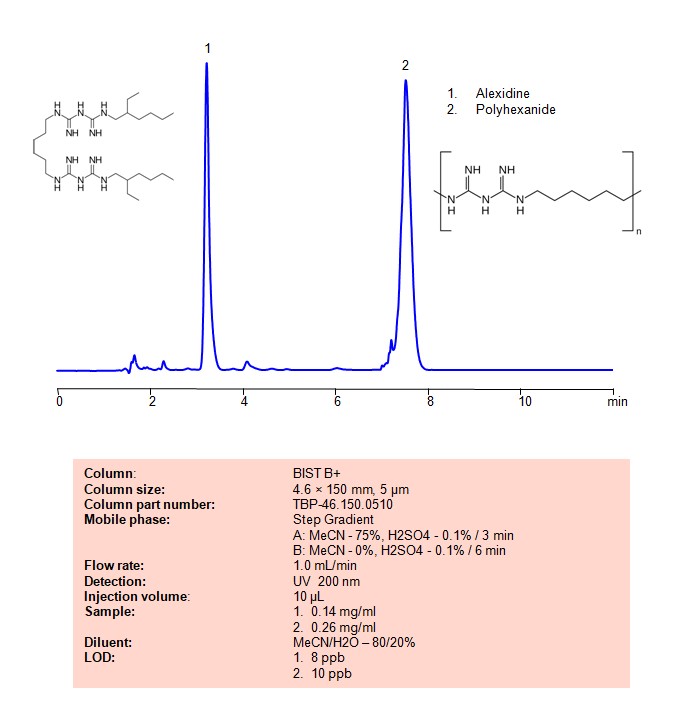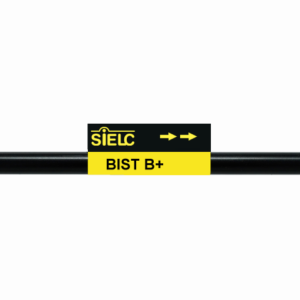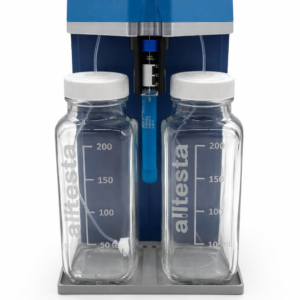High Performance Liquid Chromatography (HPLC) Method for Analysis of Polyhexanide PHMB, Alexidine on BIST B+ by SIELC Technologies
Separation type: Bridge Ion Separation Technology, or BIST™ by SIELC Technologies

Alexidine and polyhexanide are both antiseptic agents used for various applications, particularly in the field of medicine and healthcare.
- Alexidine:
- Usage: Alexidine is a bisbiguanide antiseptic that is often used in oral care products, such as mouthwashes and dental formulations.
- Antimicrobial Properties: It has broad-spectrum antimicrobial properties, effective against bacteria, fungi, and some viruses.
- Application: Alexidine has been studied for its use in controlling oral biofilm and preventing dental plaque.
- Polyhexanide:
- Usage: Polyhexanide is a polymeric biguanide antiseptic that is used in various medical applications, including wound care and disinfection.
- Antimicrobial Properties: Similar to alexidine, polyhexanide has broad-spectrum antimicrobial properties and is effective against bacteria, fungi, and some viruses.
- Application: Polyhexanide is commonly used as an antiseptic solution for wound irrigation and for the treatment of infected wounds. It can also be found in some contact lens solutions.
Both alexidine and polyhexanide belong to the biguanide class of antiseptics, and they are known for their effectiveness against a wide range of microorganisms. The specific applications and formulations may vary based on the intended use, and these agents are often used in healthcare settings to prevent infections.
Alexidine and polyhexanide can be retained, separated and analyzed on a BIST B+ mixed-mode stationary phase column using an analytical method with a simple mobile phase of water, Acetonitrile (MeCN) , and a sulfuric acid as a buffer. This analysis method can be detected using UV at 200 nm.
High Performance Liquid Chromatography (HPLC) Method for Analyses of Polyhexanide PHMB, Alexidine
Condition
| Column | BIST B+, 4.6 x 150 mm, 5 µm, 100 A, dual ended |
| Mobile Phase* | Step Gradient A: MeCN – 75%, H2SO4 – 0.1% / 3 min B: MeCN – 0%, H2SO4 – 0.1% / 6 min |
| Buffe | H2SO4 -0.1% |
| Flow Rate | 1.0 ml/min |
| Detection | UV 200 nm |
| Sample | 1. 0.14 mg/ml 2. 0.26 mg/ml |
| LOD ** | 8 ppb, 10 ppb |
| Injection volume | 10 µl |
*The step gradient methods involve sudden changes in the solvent composition of the mobile phase, resulting in the baseline’s instability. It is necessary to account for this response to be able to interpret, integrate, and process results adequately. The blank sample (sample diluent) has to be analyzed before injecting the sample of interest. When all chromatograms are generated, it is necessary to subtract the blank chromatogram from the sample one before the integration step.
**LOD was determined for this combination of instrument, method, and analyte, and it can vary from one laboratory to another even when the same general type of analysis is being performed
Description
| Class of Compounds | Bis-biguanide |
| Analyzing Compounds | Polyhexanide PHMB, Alexidine |
Application Column
BIST B+
Column Diameter: 4.6 mm
Column Length: 150 mm
Particle Size: 5 µm
Pore Size: 100 A
Column options: dual ended
Polyhexanide PHMB





